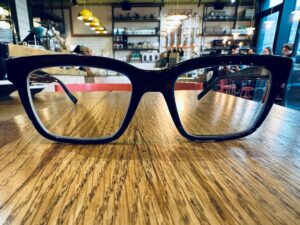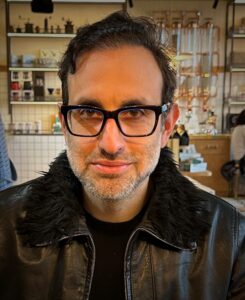Health
I swapped the high street for a bespoke eye test – here’s what happened
A strained search for the perfect eye test led Tim Samuels into the world of bespoke glasses – where specs are crafted to showcase your face, identity and, er, nose…
After the fourth appointment with the third different optician in as many months, she lowered her voice and furtively mentioned the name of another clinic. A rival optician where the tests took a mythically-long time using hospital-grade machinery.
By this point I was at the end of my optical tether – and grateful for her non-competitive candour. For months and months I’d been walking around in perpetual eye-strained dizziness. I’d clocked up a dozen appointments at multiple high-street chains, but no one had any idea why putting on my glasses triggered an intolerable strain. A multitude of prescriptions and frames were cycled through – to no avail.
How could all these professionals be consistently wrong; was I just being an eye-pochondriac? Yet, that indescribable sense of just not having the right prescription persisted.
Bespoke glasses and precision eye care
And so, I found myself sat opposite Tom Davies in his Sloane Square practice being told that I’ve got a “really tall bridge”.
Is that just code for a big schnozzle? What might generously be classified as a Pacino-esque Roman proboscis.
“It’s the distance from your eye sockets to the bridge of your nose. So you could have a short nose and a tall bridge. Or you could have a long nose and tall bridge – and that would be a big nose,” Tom says, without fully rebutting my query.
 Tom maps my face with an engineer’s eye. Taking in my brow line, hairline, eye colour, skin tone, shape of hair and nose. This personal data feeds into the construction of bespoke glasses: specs specifically tailored to fit my face.
Tom maps my face with an engineer’s eye. Taking in my brow line, hairline, eye colour, skin tone, shape of hair and nose. This personal data feeds into the construction of bespoke glasses: specs specifically tailored to fit my face.
“Bespoke is all about you. It’s about your personal style, your image – what character you want to project, how you want people to perceive you,” says Tom.
I’d not given much thought to my projecting – or apparently “round eyebrows” – until now, generally defaulting for the thick black glasses de rigueur with media folk.
I’ve been selling my tall bridge and round brows short, it seems.
How the world sees you
“The most important communication device – the thing that people identify you with – is your face,” says Tom. “To go and dress that in a frame that costs £89 for two, with a varifocal that doesn’t quite fit and doesn’t make you feel great… is absolute nonsense.”
To sell my face – now with freshly-revealed “slightly sunken eye sockets” – at the right value doesn’t come cheap. Bespoke glasses start at a thousand pounds for frame and lenses. And nor, apparently, should I be stopping at one pair.
“You should have three frames, whether bespoke or not,” Tom urges. Different frames for different occasions – and, presumably, projections.
He cited a judge he insisted wore different glasses in court to when he came home. “You can’t cuddle your boy in frames that you’ve just sent someone to prison in. You have to change character.”
Should His Lordship really want to throw off his robes and channel his inner Keanu, he could plump for one of the many frames Tom Davies crafted for the Matrix Resurrections film – replete with special nose clips to allow Neo to fend off humanity-destroying AI attack helicopters without his glasses annoyingly slipping down his (perfectly-proportioned) nose.
In the somewhat less perilous Sloane Square, Tom intently sketches out by hand the outline of frames; a more modern, lighter take on that 1950s Wayfarer look. He holds dozens of different-coloured glasses to my face before deciding a splash of subtle blue would suit – “blue is a go-to for any man”.
Science-led solutions for better eye health
Fancy frames are one thing – but what drew me through Tom Davies’ doors was the whispered promise of a next-level eye test.
‘Sisu’ is a Finnish trait – having the perseverance to complete a task that seems almost hopeless. Reaching deep into her inner sisu, optometrist Tuija Kankaanpaa led me through an hour-long eye test with resolute relish.
A battery of diagnostic machines, including some also found at Moorfields eye hospital, allow a deep dive into the retinal nerve fibre layer. This, Tuija tells me, means they can catch conditions that can otherwise be missed. Tom says they’ve even caught people with brain tumours.
Patiently, Tuija makes microscopic adjustments to prescription strengths. All a world-away from the harried high-street “red, green or both the same”.
She eventually concludes that I had indeed been mis-prescribed. No one had taken into account the onset of short-sightedness, something that tends to emerge once you turn 40. So the current glasses were correcting for distance but not for close-up work – like working on a computer screen all day.
“The prescription was way too strong. That’s why it’s so tiring,” notes Tuija. The solution is anti-fatigue lenses with a reading-friendly lower section; thankfully not old-school varifocals, but seamless digital lenses from Zeiss.
I’ve not been alone in wandering around disorientated. Tuija Kankaanpaa says the explosion in home working – with all that extra screen time – has wrought havoc on our eyesight.
“I’ve never given so many prism corrections in my life,” she says. This is where staring at screens for too long has led people to start seeing double. She says ‘office lenses’ have soared since lockdown – these are designed for days spent screen-staring, document-reading and occasionally peering up at actual humans.
The verdict
 Two weeks later, I went to pick up the new glasses – which had been hand-made in Tom Davies’ London factory. The first thing I noticed was how light they were compared to previous glasses.
Two weeks later, I went to pick up the new glasses – which had been hand-made in Tom Davies’ London factory. The first thing I noticed was how light they were compared to previous glasses.
The frames were made with lightweight Japanese Acetate – drawn from wood pulp – around a beta Titanium wire core. The fit was snug but not tight. The lenses thin and crisp. The colour a dark blue-black – but which elegantly radiates a light blue hue when it catches the light; a truly distinctive twist that even the most myopic of friends have noticed. The final flourish – my name etched onto the inside of the frame’s right arm.
Stepping outside I was struck by a sensation I’d not experienced in months: seeing without eye strain. Pounding away at the laptop, months later, I’m still free of discomfort. Projecting the must-have look of stylishly uncross-eyed.
Tim Samuels is an award-winning documentary-maker and author.





